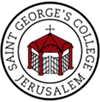Benshoof Cistern Museum

The Benshoof Cistern Museum is located in the courtyard of St George’s College in Jerusalem. It sits discreetly in the gardens. Most visitors and students give it barely a second glance.
The museum is located in an ancient water cistern, believed to date from the late Roman or early Byzantine period.
It is well worth a second glance, and even a leisurely visit.
The museum preserves and exhibits an array of ceramic items from the excavations at Tel Dothan. Those excavations were undertaken by Dr Joseph P. Free between 1953 and 1964, and a large number of pottery vessels from three excavated tombs are on display in the cistern museum.
The ancient tel of Dothan is situated on a large hill on the south side of the Dothan Valley. Dothan was strategically situated along an ancient highway connecting the hill country of Manasseh with the Jezreel valley.
Some of the ruins date to the Middle Bronze Period (2300–1550 BCE), which would correspond to the time of Joseph. Other evidence has been found of the town’s destruction by the Assyrians either during the conquest of Galilee by Tiglath-pileser III in 732 BCE (2 Kings 15:29), or during the fall of Samaria ten years later in 722 BCE (2 Kings 18:10).
Much of the site remains unexcavated, but pottery from three tombs in the western cemetery at Dothan is displayed in the Benshoof Cistern Museum. The majority of the pieces are from Tomb 1, which is one of the largest single-chambered cave burials from the Late Bronze Age and Early Iron Age to have been excavated in the region. This one cave contained remains from 250–300 Canaanite burials between the 1400 BCE and the 1200 BCE.
The museum is arranged so that vessels of similar type are displayed together. This allows even the casual visitor to notice the diversity and variety of forms in the same basic style of vessel: lamps, goblets, craters, bowls, pyxides, etc.
The museum is a valuable research collection for scholars while also being of interest to students of the college and visitors to the Cathedral.
Check it out next time you are here at the College.
The Benshoof Cistern Museum was made possible by a generous gift from Edward and Barbara Benshoof.
